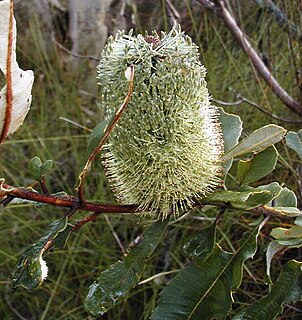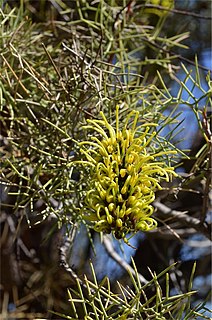
The Piperaceae, also known as the pepper family, are a large family of flowering plants. The group contains roughly 3,600 currently accepted species in 5 genera. The vast majority of species can be found within the two main genera: Piper and Peperomia.

Cornus canadensis is a species of flowering plant in the dogwood family Cornaceae, native to eastern Asia and North America. Common names include Canadian dwarf cornel, Canadian bunchberry, quatre-temps, crackerberry, and creeping dogwood. Unlike its relatives, which are for the most part substantial trees and shrubs, C. canadensis is a creeping, rhizomatous perennial growing to about 20 centimetres tall.

Banksia petiolaris is a rare species of flowering plant in the family Proteaceae native to Western Australia, where it is found in sandy soils in the south coastal regions from Munglinup east to Israelite Bay. It was first described by Victorian state botanist Ferdinand von Mueller in 1864, and no subspecies are recognised. B. petiolaris is one of several closely related species that will all grow as prostrate shrubs, with horizontal stems and thick, leathery upright leaves. Those of this species can be viable for up to 13 years—the longest-lived of any flowering plant recorded. It bears yellow cylindrical flower spikes, known as inflorescences, up to 16 cm high in spring. As the spikes age, they turn grey and develop up to 20 woody seed pods, known as follicles, each.

Banksia grossa is a species of shrub in the family Proteaceae and is endemic to Southwest Australia. It is one of fourteen species of banksia of the series Abietinae, all of which bear predominantly cylindrical or oval inflorescences. Collected in 1965, it was first formally described in 1981 by Alex George. Its thick leaves and large seeds distinguish it from other members of the Abietinae, and are the basis of its species name.

Banksia media, the southern plains banksia or golden stalk banksia, is a species of flowering plant in the family Proteaceae. An evergreen shrub, it occurs on the south coast of Western Australia between Albany and Israelite Bay, where it is a common plant. A many-branched bush with wedge-shaped serrated leaves and large golden-yellow flower spikes, known as inflorescences, it grows up to 10 metres (30 ft) high.

Banksia oblongifolia, commonly known as the fern-leaved, dwarf or rusty banksia, is a species in the plant genus Banksia. Found along the eastern coast of Australia from Wollongong, New South Wales in the south to Rockhampton, Queensland in the north, it generally grows in sandy soils in heath, open forest or swamp margins and wet areas. A many-stemmed shrub up to 3 m (9.8 ft) high, it has leathery serrated leaves and rusty-coloured new growth. The yellow flower spikes, known as inflorescences, most commonly appear in autumn and early winter. Up to 80 follicles, or seed pods, develop on the spikes after flowering. Banksia oblongifolia resprouts from its woody lignotuber after bushfires, and the seed pods open and release seed when burnt, the seed germinating and growing on burnt ground. Some plants grow between fires from seed shed spontaneously.

Banksia blechnifolia is a species of flowering plant in the genus Banksia found in Western Australia. It was first described by Victorian state botanist Ferdinand von Mueller in 1864, and no subspecies are recognised. It gained its specific name as its leaves are reminiscent of a fern (Blechnum). B. blechnifolia is one of several closely related species that grow as prostrate shrubs, with horizontal stems and leathery, upright leaves. The red-brown flower spikes, known as inflorescences, are up to 20 centimetres (8 in) high and appear from September to November in the Australian spring. As the spikes age, each turns grey and develops as many as 25 woody seed pods, known as follicles.
Banksia idiogenes is a species of tufted shrub that is endemic to Western Australia. It has hairy stems, deeply pinnatifid leaves, distinctive, scented, red and white flowers in heads of about eighty, later several glabrous, egg-shaped follicles in each head.
Banksia ionthocarpa is a species of shrub that is endemic to Western Australia. It has short, hairy, prostrate stems, pinnatifid leaves, pinkish purple to orange flower in heads of between forty and sixty at the base of leaves, and egg-shaped follicles with a distinctive tuft of hairs on the end.
Banksia tortifolia is a small, spreading, prostrate shrub that is endemic to the southwest of Western Australia. It has short underground stems, pinnatipartite leaves with sharply-pointed, linear lobes on each side, greenish-cream, yellow and pink flowers in heads of about eighty, and glabrous, egg-shaped follicles.

Caltha leptosepala, the white marsh marigold, twinflowered marsh marigold, or broadleaved marsh marigold, is a perennial species of flowering plant in the buttercup family. It is native to western North America from Alaska to New Mexico, where it grows in wet mountain habitats in alpine and subalpine regions. There are two general wild types of this species, one native to the interior and one that grows along the Pacific coast and coastal mountains, but these are not always treated separately.

Adenanthos obovatus, commonly known as basket flower, or, jugflower, is a shrub of the plant family Proteaceae endemic to Southwest Australia. Described by French naturalist Jacques Labillardière in 1805, it had first been collected by Archibald Menzies in 1791. Within the genus Adenanthos, it lies in the section Eurylaema and is most closely related to A. barbiger. A. obovatus has hybridized with A. detmoldii to produce the hybrid A. × pamela. Several common names allude to the prominent red flowers of the species. It grows as a many-stemmed spreading bush up to 1 m (3.3 ft) high, and about 1.5 m (4.9 ft) across, with fine bright green foliage. Made up of single red flowers, the inflorescences appear from April to December, and peak in spring.

Hakea chordophylla, commonly known as bootlace oak, bootlace tree, corkwood, or bull oak, is a species of shrub or small tree in the family Proteaceae found in central and northern Australia. Bares very showy golden yellow, pale green or cream nectar rich flowers in winter.

Campanula piperi is a species of flowering plant in the bellflower family, Campanulaceae. It is native to the Olympic Mountains on the Olympic Peninsula in the U.S. state of Washington. It has also been noted on Vancouver Island, British Columbia.
Lupinus bingenensis, common name bingen lupine or Suksdorf's lupine, is a plant species native to the US states of Washington, Idaho, Montana and Oregon as well as from British Columbia. Lupinus grows well in mountainous regions. The name honors the city of Bingen, in Klickitat County, Washington.

Hakea circumalata is a shrub in the family Proteaceae native to an area in the Wheatbelt and Mid West regions of Western Australia. A small shrub producing a profusion of strongly scented pink to red flowers in dense clusters from July to September.

Hakea divaricata, commonly known as needlewood, corkbark tree or fork-leaved corkwood, is a tree or shrub in the family Proteaceae native to an area in central Australia. A slow growing species with up to 120 showy cream to greenish-yellow flowers in long racemes from June to November.

Leucospermum saxosum is an upright evergreen shrub of up to 2 m (6.6 ft) high, that is assigned to the family Proteaceae. It has lance-shaped, leathery leaves and egg-shaped flower heads of about 5 cm (2.0 in) in diameter, with initially yellow-orange flowers, later turning crimson, from which long styles stick out, giving the flower head the appearance of a pincushion. It is called escarpment pincushion in English. It grows on quartzite soils in the mountains on the Zimbabwe-Mozambique border and in eastern Transvaal.

Leucospermum pedunculatum is an evergreen, low shrub of 15–30 cm (5.9–11.8 in) high spreading from a single stern upright stem, from the family Proteaceae. The powdered or hairless line-shaped to somewhat sickle-shaped leaves are 3–6 cm (1.2–2.4 in) long and 2–5 mm (0.08–0.20 in) wide. The stalked, individually set flower heads are globe-shaped, 2½−3 cm in diameter consist of initially white to pale cream flowers that eventually turn carmine. From the center of the flowers emerge straight styles that jointly give the impression of a pincushion. It is called white-trailing pincushion in English. It flowers from August to January, peaking in September. It is an endemic species that is restricted to a narrow strip on the south coast of the Western Cape province of South Africa.

Hypericum majus, the greater Canadian St. John's wort, is a perennial herb native to North America. The specific epithet majus means "larger". The plant has a diploid number of 16.















